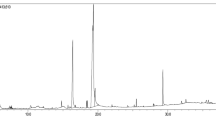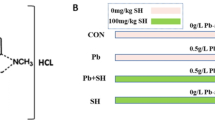Abstract
Chromium (VI) is as an extremely toxic chemical substance, and is also an internationally recognized human carcinogen. The principal objective of this study was to determine whether or not Styrax japonica Siebold et al. Zuccarini (SJSZ) glycoprotein prevents hepatocarcinogenesis in chromium-treated BNL CL.2 cells and ICR mice. Firstly, it was evaluated that SJSZ glycoprotein has strong antioxidant character and scavenges radicals. In an effort to assess the chemopreventive effects of SJSZ glycoprotein on hepatocarcinogenesis, ICR mice were intraperitoneally injected with chromium (10 mg/kg, BW) for 8 weeks. After sacrifice, we evaluated indicators of liver tissue damage [the activities of lactate dehydrogenase (LDH) and alanine aminotransferase (ALT), and thiobarbituric acid-reactive substances (TBARS)], antioxidative enzymes [activities of superoxide dismutase (SOD), catalase (CAT) and gluthathione peroxidase (GPx)], and initiating hepatocarcinogenic indicator [heat shock protein (HSP) 27 and 70] and protein kinase C (PKC), p38 MAPK and PCNA via biochemical methods and immunoblot analysis. The results obtained from this study demonstrated that the SJSZ glycoprotein (50 μg/ml) inhibited the production of intracellular ROS in BNL CL.2 cells. In addition, the SJSZ glycoprotein (10 mg/kg, BW) attenuated the levels of LDH, ALT, and TBARS, whereas it increased antioxidative enzymes in mouse serum. SJSZ glycoprotein attenuated the activity of HSP27, HSP70, PKC, MAPKs, and PCNA in BNL CL.2 cells and liver tissue. Taken together, our results indicate that SJSZ glycoprotein might be have a potent preventive effect against hepatocarcinogenesis induced by oxidative stress.








Similar content being viewed by others
References
Langard S (1983) The carcinogenicity of chromium compounds in man and animals. In: Burrows D (ed) Chromium D metabolism and toxicity. Boca Raton, CRC Press, pp 13–30
Becker N, Chang-Claude J, Frentzel-Beyme R (1991) Risk of cancer for arc welders in the Federal Republic of Germany: results of a second follow up. Br J Ind Med 48:675–683
Susa N, Ueno S, Furukawa Y (1998) Protective effect of diethyldithiocarbamate pretreatment on chromium (VI)-induced cytotoxicity and lipid peroxidation in primary cultures of rat hepatocytes. J Vet Med Sci 60:71–76
Nishigori C (2006) Cellular aspects of photocarcinogenesis. Photochem Photobiol Sci 5:208–214
Sundaresan S, Subramanian P (2003) S-allylcysteine inhibits circulatory lipid peroxidation and promotes antioxidants in N-nitrosodiethylamine-induced carcinogenesis. Pol J Pharmacol 55:37–42
Hold GL, El-Omar EM (2008) Genetic aspects of inflammation and cancer. Biochem J 410:225–435
Joo M, Chi JG, Lee H (2005) Expressions of HSP70 and HSP27 in hepatocellular carcinoma. J Korean Med Sci 20:829–834
Kim G, Yurkow EJ (1996) Chromium induces a persistent activation of mitogen-activated protein kinases by a redox-sensitive mechanism in H4 rat hepatoma cells. Cancer Res 56(9):2045–2051
Yoshikawa K, Hirai H, Tanaka M, Arihara S (2000) Antisweet natural products. XV. Structures of Jegosaponins A-D from Styrax japonica Sieb. et Zucc. Chem Pharm Bull 48:1093–1096
Neville DM Jr, Glossmann H (1974) Molecular weight determination of membrane protein and glycoprotein subunits by discontinuous gel electrophoresis in dodecyl sulfate. Methods Enzymol 32:92–102
Masuko T, Minami A, Iwasaki N, Majima T, Nishimura S, Lee YC (2005) Carbohydrate analysis by a phenol-sulfuric acid method in microplate format. Anal Biochem 339:69–72
Lowry OH, Rosebrough NJ, Farr AL, Randall RJ (1951) Protein measurement with the Folin phenol reagent. J Biol Chem 193:265–275
Maffei Facino R, Carini M, Aldini G, Berti F, Rossoni G (1999) Panax ginseng administration in the rat prevents myocardial ischemia-reperfusion damage induced by hyperbaric oxygen: evidence for an antioxidant intervention. Planta Med 65:614–619
Halliwell B, Gutteridge JM, Aruoma OI (1987) The deoxyribose method: a simple test-tube assay for determination of rate constants for reactions of hydroxyl radicals. Anal Biochem 16:215–219
Lee JC, Lim KT (2001) Inhibitory effects of the ethanol extract of Ulmus davidiana on apoptosis induced by glucose–glucose oxidase and cytokine production in cultured mouse primary immune cells. J Biochem Mol Biol 34:463–471
Bergmeyer HU, Bernt E (1974) UV-assay with pyruvate and NADH. In: Bergmeyer HU (ed) Methods of enzymatic analysis, vol 2. Academic Press, New York, pp 574–578
Bergmeyer HU, Bernt E (1974) Glutamate-pyruvate transaminase: UV assay, manual method. In: Bergmeyer HU (ed) Methods of enzymatic analysis, vol 2. Academic Press, New York, pp 752–758
Ohkawa H, Ohishi N, Yagi K (1979) Assay for lipid peroxides in animal tissues by thiobarbituric acid reaction. Anal Biochem 95:351–358
Kakkar P, Das B, Viswanathan PN (1984) A modified spectrophotometric assay of superoxide dismutase. Indian J Biochem Biophys 21:130–132
Thomson JF, Nance SL, Tollaksen SL (1978) Spectrophotometric assay of catalase with perborate as substrate. Proc Soc Exp Biol Med 157:33–35
Rotruck JT, Pope AL, Ganther HE, Swanson AB, Hafeman DG, Hoekstra WG (1973) Selenium: biochemical role as a component of glutathione peroxidase. Science 179:588–590
Patton WF, Dhanak MR, Jacobson BS (1989) Differential partitioning of plasma membrane proteins into the triton X-100-insoluble cytoskeleton fraction during concanavalin A-induced receptor redistribution. J Cell Sci 92:85–91
Gabelman BM, Emerman JT (1992) Effects of estrogen, epidermal growth factor, and transforming growth factor-a on the growth of human breast epithelial cells in primary culture. Exp Cell Res 201:113–118
Hong WK, Sporn MB (1997) Recent advances in chemoprevention of cancer. Science 278:1073–1077
Geetha S, Sai Ram M, Mongia SS, Singh V, Ilavazhagan G, Sawhney RC (2003) Evaluation of antioxidant activity of leaf extract of Seabuckthorn (Hippophae rhamnoides L.) on chromium(VI) induced oxidative stress in albino rats. J Ethnopharmacol 87:247–251
Rohr-Udilova NV, Stolze K, Sagmeister S, Nohl H, Schulte-Hermann R, Grasl-Kraupp B (2008) Lipid hydroperoxides from processed dietary oils enhance growth of hepatocarcinoma cells. Mol Nutr Food Res 52:352–359
Tarao K, Rino Y, Ohkawa S, Shimizu A, Tamai S, Miyakawa K, Aoki H, Imada T, Shindo K, Okamoto N, Totsuka S (1996) Association between high serum alanine aminotransferase levels and more rapid development and higher rate of incidence of hepatocellular carcinoma in patients with hepatitis C virus-associated cirrhosis. Cancer 86:589–595
Banakar MC, Paramasivan SK, Chattopadhyay MB, Datta S, Chakraborty P, Chatterjee M, Kannan K, Thygarajan E (2004) 1alpha, 25-dihydroxyvitamin D3 prevents DNA damage and restores antioxidant enzymes in rat hepatocarcinogenesis induced by diethylnitrosamine and promoted by phenobarbital. World J Gastroenterol 10:1268–1275
Bagchi D, Vuchetich PJ, Bagchi M, Hassoun EA, Tran MX, Tang L, Stohs SJ (1997) Induction of oxidative stress by chronic administration of sodium dichromate [chromium VI] and cadmium chloride [cadmium II] to rats. Free Radic Biol Med 22:471–478
Nordberg J, Arner ES (2001) Reactive oxygen species, antioxidants, and the mammalian thioredoxin system. Free Radic Biol Med 31:1287–1312
Margaill I, Plotkine M, Lerouet D (2005) Antioxidant strategies in the treatment of stroke. Free Radic Biol Med 39:429–443
Vásquez-Garzón VR, Arellanes-Robledo J, García-Román R, Aparicio-Rautista DI, Villa-Treviño S (2009) Inhibition of reactive oxygen species and pre-neoplastic lesions by quercetin through an antioxidant defense mechanism. Free Radic Res 43:128–137
Bagchi D, Bagchi M, Tang L, Stohs SJ (1997) Comparative in vitro and in vivo protein kinase C activation by selected pesticides and transition metal salts. Toxicol Lett 91:31–37
Cuenda A, Rousseau S (2007) p38 MAP-Kinases pathway regulation function and role in human diseases. Biochem Biophys Acta 1773:1358–1375
Zhang J, Shen B, Lin A (2007) Novel strategies for inhibition of the p38 MAPK pathway. Trends Pharmacol Sci 28:286–295
Sakamoto M (2009) Early HCC: diagnosis and molecular markers. J Gastroenterol 44:108–111
Acknowledgment
This study was financially supported by Chonnam National University, 2011.
Author information
Authors and Affiliations
Corresponding author
Rights and permissions
About this article
Cite this article
Lee, J., Lim, KT. Inhibitory effect of SJSZ glycoprotein (38 kDa) on expression of heat shock protein 27 and 70 in chromium (VI)-treated hepatocytes. Mol Cell Biochem 359, 45–57 (2012). https://doi.org/10.1007/s11010-011-0998-8
Received:
Accepted:
Published:
Issue Date:
DOI: https://doi.org/10.1007/s11010-011-0998-8




